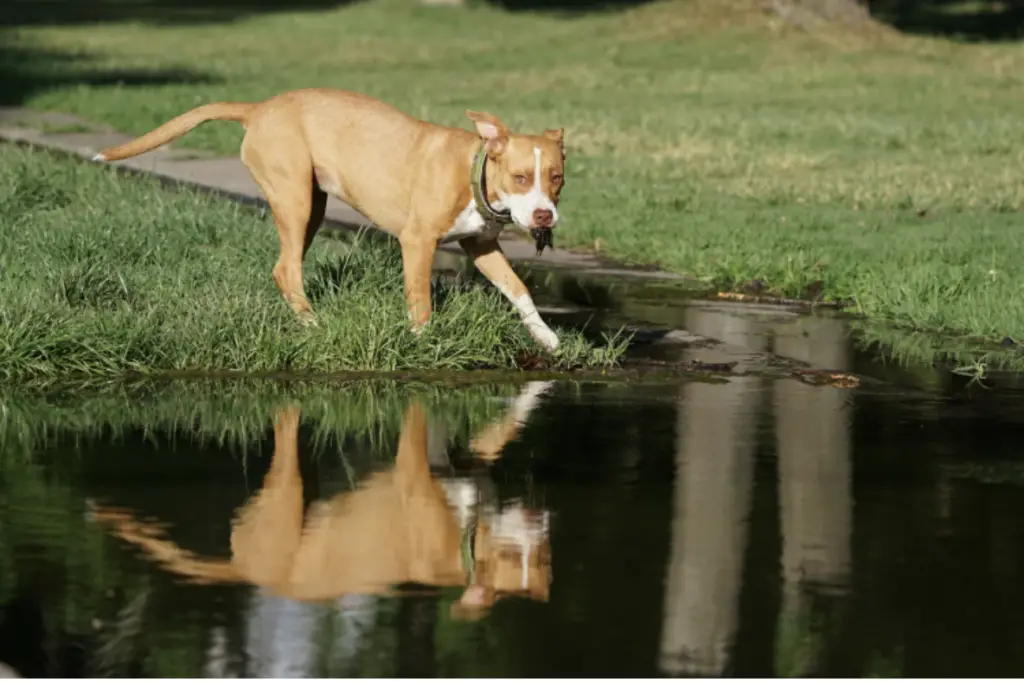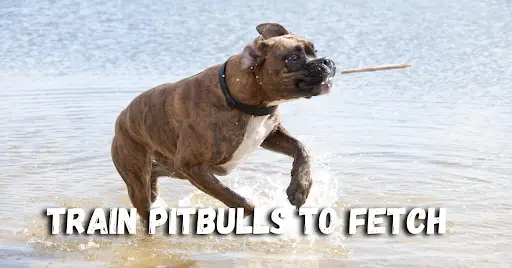Pitbulls are often misunderstood due to their negative media portrayal. However, with proper training and socialization, these dogs can be loyal and loving companions.
One of the most common and enjoyable activities for dogs is playing fetch. While some breeds may naturally have a knack for fetching, pitbulls may require more patience and training to learn this skill.
In this ultimate guide, we will cover everything you need to know about teaching your pitbull to fetch.
Teach Pitbull to Fetch: The Easy Way

Before we dive into the specifics of training, let’s first understand why pitbulls may require a different approach to learning fetch.
Pitbulls are known for their high energy levels and strong personalities. They are also known for being strong-willed and independent, which can sometimes make training challenging. Additionally, some pitbulls may have a high prey drive, making them more inclined to chase after objects but less likely to bring them back.
However, pitbulls are also intelligent and eager to please their owners. With positive reinforcement training techniques, patience, and consistency, pitbulls can learn to fetch just like any other breed. It’s important to approach training with an open mind and an understanding that each dog learns at their own pace.
What You’ll Need
Before starting any training, you’ll need to gather a few supplies. The first and most important thing you’ll need is a high-quality fetch toy. This can be anything from a traditional tennis ball to a frisbee or a rope toy. Just make sure it’s durable and safe for your dog to play with.
You’ll also need a leash, treats, and a designated area for training. This can be a fenced-in yard, a park, or any other secure outdoor space. You may also want to invest in a long training lead to give your dog more freedom to run and fetch while still being under your control.
When selecting a leash, choose one that is sturdy and comfortable for you and your dog. A standard 6-foot leash is usually sufficient for training, but a longer lead may be useful for practicing fetch in larger spaces.
Training Your Pitbull to Fetch
Now that you have your supplies, it’s time to start training your pitbull to fetch. Here are some steps to follow:
- Start with Chasing
The first step is to get your pitbull interested in chasing after the toy. Throw the toy a short distance and encourage your dog to go after it. If your dog is not interested, try using a more exciting toy or treat to motivate them. Be patient and keep practicing until your dog is constantly chasing after the toy.
- Add Some Extra Motivation
Once your dog is chasing after the toy, you’ll want to encourage them to bring it back to you. Start by calling your dog back to you and rewarding them with a treat when they return with the toy. You can also try using a second toy to entice your dog to come back to you. As your dog becomes more comfortable with bringing the toy back to you, gradually increase the distance of your throws.
- Teach the “Drop It” Command
The next step is to teach your dog to release the toy once they bring it back to you. Start by offering a treat in exchange for the toy, and say “drop it” as you take it from their mouth. Once your dog starts to understand this command, you can gradually phase out the treat rewards. It’s important to be consistent and patient when training this command, as it can be useful for many other aspects of training and daily life.
- Gradually Increase Difficulty
As your pitbull becomes more comfortable with fetching, you can gradually increase the difficulty level. This can include throwing the toy farther, using different types of toys, and practicing in different environments. Remember to always reward your dog for its successes and be patient when they struggle with new challenges.
Choosing the Right Fetch Toy

Choosing the right fetch toy is crucial for successful training. Here are some tips for selecting the right toy for your pitbull:
Durability
Pitbulls are strong chewers, so you’ll want to select a durable toy that can withstand some rough play. Look for toys made from tough, chew-resistant materials that won’t break or tear easily.
Size
It’s best to choose a toy that fits the size of your pitbull. If the toy is too big or small, it can be uncomfortable for your pup and discourage them from playing. Additionally, toys that are too small may pose a choking hazard, so always be mindful of the size when selecting a toy.
Texture
The texture of the toy is also important. If a toy is too hard or soft, your dog may not enjoy playing with it. Look for toys with a variety of textures that will engage and stimulate your pitbull’s senses. Ideally, the toy should be soft enough for your pup to pick up and carry but sturdy enough to withstand wear and tear.
Safety
Toys should be made from non-toxic materials that won’t break or splinter and pose a choking hazard. If a toy has small parts such as buttons or bells, make sure they are securely attached, and there is no risk of them coming off and getting swallowed by your pup.
What If Your Pitbull Isn’t Interested?
If your pitbull doesn’t seem interested in fetching, don’t give up hope. Here are some tips for getting your dog excited about playing fetch:
Use a High-Value Reward
Try using a high-value reward, such as a piece of chicken or cheese, to motivate your dog to chase after the toy. You can also use their regular kibble as a reward, but it will likely be less motivating than something they don’t get to eat every day.
Make it Fun
Try incorporating other games into your fetch training, such as tug-of-war or hide-and-seek. This can make training more fun and engaging for your dog. Pitbulls are highly intelligent and love problem-solving, so these activities can be a great way to hold their interest.
Be Patient
Remember that it takes time and patience to teach your dog to fetch. Don’t get discouraged if they seem uninterested or don’t pick up the toy right away. With time and patience, you can have a fetching machine in no time!
Common Pitfalls to Avoid
When training your pitbull to fetch, there are some common pitfalls to avoid. Here are some things to keep in mind:
- Don’t Force It
If your dog is not interested in playing fetch, don’t force them to do it. This can cause frustration and anxiety for both you and your dog. Pitbulls are intelligent and will eventually learn to enjoy the game if you take your time and remain patient.
- Don’t Overdo It
Playing fetch can be a great form of exercise for your pitbull, but it’s important not to overdo it. Too much exercise can lead to injury and exhaustion, so make sure to give your pup plenty of breaks and listen to their cues. If they seem tired or are displaying signs of discomfort, it’s time to take a break.
- Don’t Punish Mistakes
Your dog may make mistakes during training, but punishing them will only serve to discourage them from trying again. Instead, reward your pup for good behavior and use positive reinforcement techniques to encourage them to keep trying.
Conclusion
Teaching your pitbull to fetch can be a fun and rewarding experience for both you and your dog.
By following the steps and tips outlined in this guide, you can help your pitbull develop this skill and strengthen your bond in the process. Remember to be patient and always use positive reinforcement techniques.


